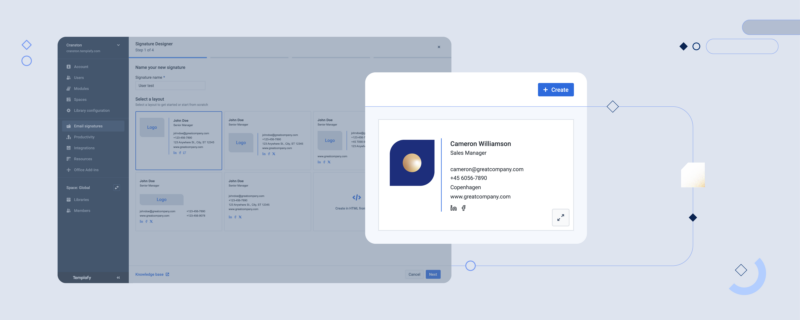Any business looking to stay fresh and relevant will eventually need to consider a rebrand or brand refresh. Maybe you want to attract a new target audience, remain competitive as new players enter the market, or change the way people think about your product or service.
Take Uber's recent brand refresh as an example. The major app-based ride-sharing company released its second big brand refresh in less than three years by updating its logo, typeface and redesigning its mobile app.
Uber's most recent brand refresh signifies a more inclusive brand message as it seemed consumers were not connecting to its previous brand identity the way the company had hoped they would. For example, some Uber drivers were even turning the company-supplied decal inside out to display the full company name and not just the iconic "U", as had originally been intended.

This emphasized the importance of a powerful corporate typeface that accurately portrays a company's personality. Uber chose to design a new custom typeface called "Uber Move" that encompasses a similar style to those used for transportation signage around the world. This font uses less capital letters to help achieve Uber's goal of becoming more accessible and relatable to users worldwide.
While the result of a rebranding process can be a stronger, more lucrative market repositioning, the stakes can also seem high: after all, your brand is both your reputation and your visibility. For some managers, the prospect of overhauling their entire visual brand identity – or even just tinkering with it – can also feel like an insurmountable task, one that distracts from the important job of running the business.
But a rebranding process doesn’t have to be the chaotic, stressful experience it’s made out to be. We discuss three rebrand tips for a smart approach to the transition and explore how Templafy’s solutions can ensure that your rebranding process goes as smoothly and successfully as possible.
Rebrand Tip No. 1 - Maintain authenticity
Changing your visual brand identity is a delicate balancing act. First up on a rebranding process timeline should be ways to find the happy medium between what your customers know you as, and how you want them to think of your company in the future.
According to Pamela Webber, Chief Marketing Officer of 99designs, your rebranding process should be a step forward, but it certainly shouldn’t alienate your original customer base or fundamental values. In an interview with Business News Daily, she says the idea is that your upgraded brand identity still resonates with your existing audience:
"You don't want to lose sight of that. Embrace the newness and evolution that comes with a new type of customer base or product, but also keep your core fundamentals. Make sure that whatever you do as part of your rebrand is authentic to you, your employees and your customers."
For inspiration on how to strike that perfect balance between the old and the new, look to rebranding processes that have achieved global success. One famous example of standout execution of new brand strategy is Old Spice – an antiperspirant which went from a dowdy grandpa scent to seductive and alluring with a tongue-in-cheek ad campaign featuring a chiselled sports star telling women “look at your man, now back to me. Unfortunately, he’s not me.” The sense of humor was an instant hit with younger consumers and quickly went viral on social media. While a small business obviously couldn’t match a global ad campaign, the case is a lesson in how a brand can leave a product relatively unchanged so old customers still recognize it (Old Spice didn’t even change its logo), but completely transform its image to reach an entirely new audience.
Rebrand Tip No. 2 - Have a brand launch plan
Of course, there’s no point in investing in a brand overhaul unless you make the effort to generate awareness – that’s why it’s crucial to develop a plan to promote and strengthen your new brand. We cover the fundamental things you must do when launching a brand identity update.
For some, a rebrand may mean that your exposure takes a hit – but you can minimize that risk by being prepared to re-educate your audience and rebuild your brand awareness in the face of change. Don’t assume that a new look will perform the job for itself – brand managers who take shortcuts on developing long-term strategies after a rebranding process often end up feeling like the process set them back. Strive to clearly communicate your new brand identity and where it puts you in the marketplace.
And don’t forget to strategize how to launch it internally: it’s critical for your employees to embrace your new brand. Marketing specialists will attest to the fact that what starts within spreads throughout. Employees are on the marketing front line and the best ambassadors for your product or service: a strong effort to communicate your new brand to your team effectively gives them the best tools to reach out to customers and spread your message to the market.
Rebrand Tip No. 3 - Ensure everything is on-brand
So your rebranding process flows from all the effort invested in developing new visual elements with a designer – things like logos, tagline, colors and design – but how do you ensure you can roll them out across the board, including internally? It’s easy to throw out your old mugs, business cards and stationery and replace them with upgrades – but you need put your new stamp on all internal and external digital assets to ensure visual identity is implemented consistently. Think presentation decks, contracts and spreadsheets, which often get overlooked in a rebrand.
Ensure your colleagues can access new brand elements easily with Templafy
Brand authenticity can only be established through consistent application of your new branding across all communication points. If after the rebranding process employees are circulating old brand visuals, whether logo designs, outdated images or old company fonts, customers and potential clients will be met with a confused brand experience, meaning your brand image takes a serious hit.
Dynamic templates and Templafy’s BrandChecker not only save your employees time and maximize productivity, but this form of workplace automation goes a long way to ensure consistency and brand integrity across your channels. Through Templafy’s centralized dashboard, authorized individuals such as Brand Managers can create editable document, presentation and email templates, which are then rolled out enterprise-wide. Once an employee opens the template it’s automatically populated with all their personal details, correct brand assets including font and logo designs, as well as up-to-date legal disclaimers. Integrated with cloud-hosted content libraries of pre-approved assets, individuals no longer waste time Googling visuals to match your new brand guidelines or go rogue with off-brand images. And if they do, BrandChecker helps put them back on track by assessing the document content against the best-practice content stored in the cloud (more about this below). Essentially Templafy offers an effective toolset that avoids any clashes between your new and old brand worlds.
Are your email signatures up-to-date with your new brand identity?
A key element of internal branding that is frequently missed out of rebranding process steps is email signature strategy, with many businesses failing to realize the power a sign-off has on your brand image. With employees sending around 40 business emails daily, imagine how many times email recipients see your new branding visuals; particularly your logo design, font and messaging. Pair this with tasking busy employees to manage and regularly update email signatures with new branding, and it’s highly likely you’re putting your brand equity at unnecessary risk.
Templafy’s Email Signature Manager keeps Brand Managers in control of email branding through centralized brand-governance, ensuring every email sent from your company is formatted correctly, on-brand and personalized with individual employee details. Email signature campaigns promoting your new brand launch can also be customized for different individuals, departments and countries to ensure you’re promoting your new branding at every possible opportunity.
Smart tools can do the brand-policing for you after the roll out
Once, this might have meant endless manpower (and endless errors), but today, Templafy can automate processes and do the job for you. Alongside Templafy’s dynamic templates and Email Signature Manager, our Brand & Compliance Checker is a quick fix to maintaining visual compliance across your internal content. Whenever an employee uses an off-brand element in a document or email, they’re instantly alerted and provided with alternative, brand compliant options. Even if someone happens to open an old document to edit from their desktop, they’ll get an alert through the Templafy task pane that they’re breaking the guidelines. BrandChecker does the brand policing for you. Sounds pretty great, right? It's the simplest and quickest way to get the whole company on board with the rebrand.
Watch this short video to learn more about how Templafy can assist with a smooth rebranding process:




